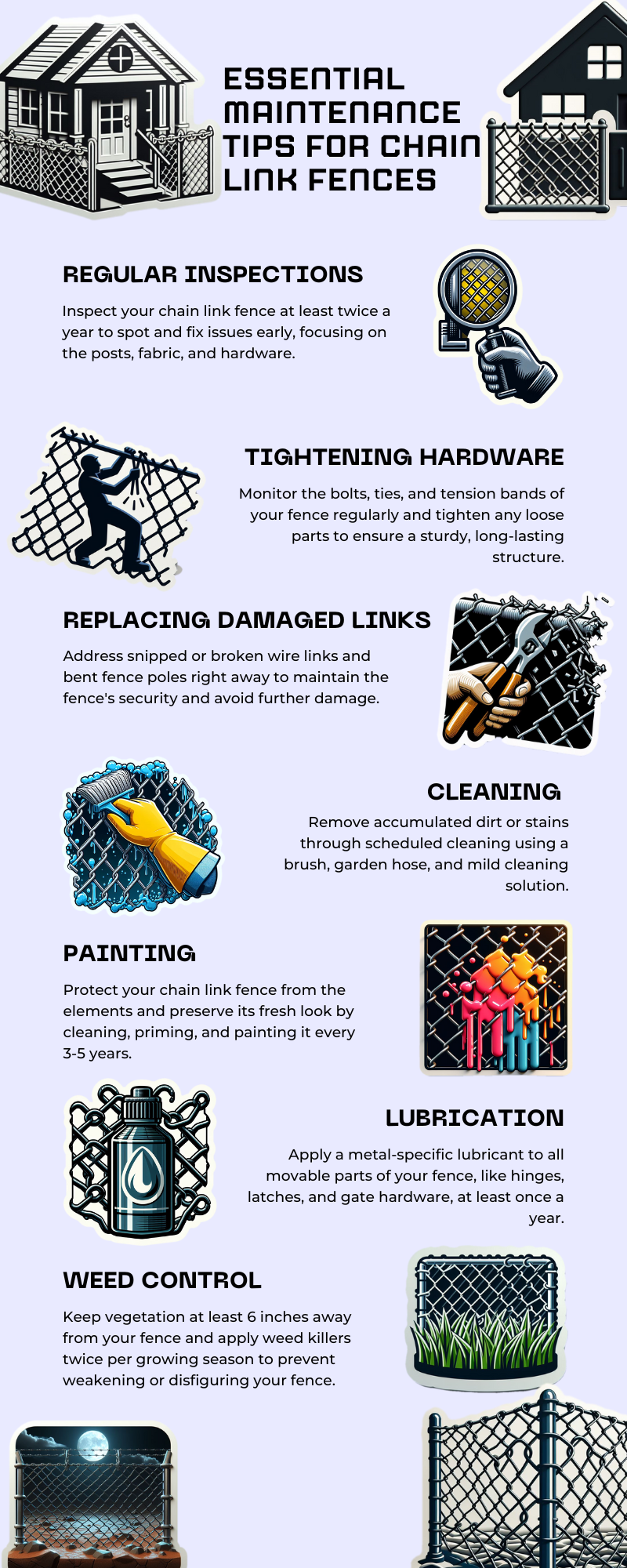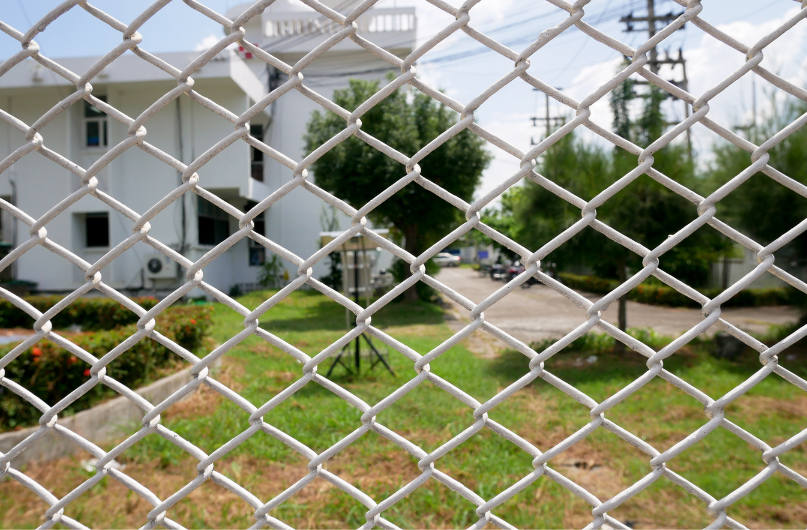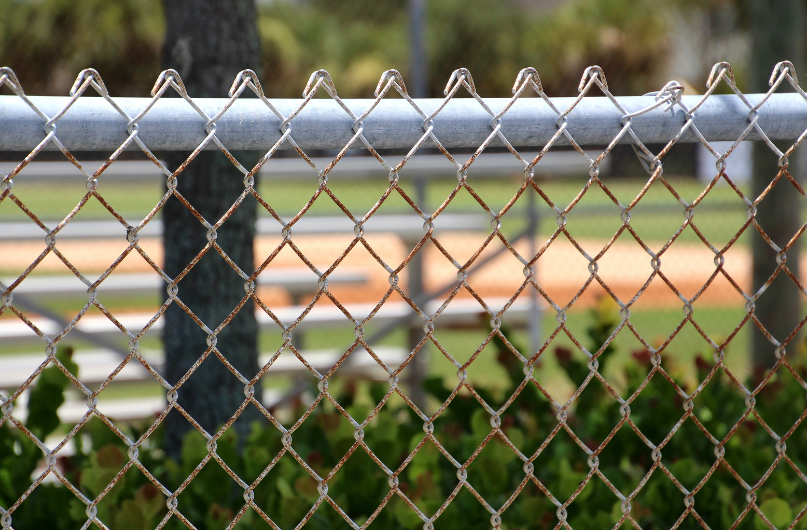Chain link fencing is one of the most common types of fencing used for both residential and commercial properties. It consists of wire loops linked together to form a mesh pattern with diagonal diamond shapes. The fencing comes in galvanized steel, vinyl coated steel, or aluminum.
Some key benefits of chain link fencing include:
Cost-effective – Chain link fencing is relatively inexpensive compared to other fencing options. It’s easy to install, requiring minimal maintenance over its lifetime. This makes it a budget-friendly choice.
Durable – Properly installed chain link fences can last for decades. The galvanized coating provides protection against corrosion and rust. Vinyl coating offers further longevity.
Security – The woven pattern makes chain link fencing difficult to cut through or climb. It provides visibility while maintaining a barrier, making it popular for security purposes.
Customizable – Chain link fencing can be customized in height and gauge (thickness) to suit specific needs. You can also add privacy slats, barbed wire, or other accessories.
Low maintenance – Basic upkeep is required but chain link fencing is generally one of the lowest maintenance fence types available. It doesn’t require painting or staining.
With proper installation and maintenance, chain link can provide security and aesthetics for many years. The rest of this article will overview recommended maintenance tasks to maximize the lifetime of your chain link fence.

Regular Inspections
Chain link fences should be inspected at least twice a year – once in the spring and once in the fall. Regular inspections allow you to spot issues and make repairs before small problems turn into big headaches.
When inspecting your fence, walk the entire perimeter and look closely at the posts, fabric, and hardware. Some key things to check for include:
Loose or sagging wires. Tight wires are important for security and appearance. Sagging wires can also place additional strain on posts.
Missing fasteners like wire ties or tension bands. These small parts play a crucial role in keeping your fence taut and connected. Even one missing fastener can compromise the strength of your fence.
Rust on the wires, posts, or hardware. While some surface rust is normal, excessive rust can weaken the integrity of the metal. Keep an eye out for flaking or powdery rust.
Damaged or bent metal, including posts, fabric, and wire. Look for any spots where the fence is dented, warped, or broken. Even minor damage will tend to worsen over time.
Holes dug under the fence, especially near the bottom of posts. This may indicate an animal has dug under the fence and compromised its security.
Regular inspections take some time but are essential for any chain link fence owner. Spotting issues early allows you to make minor repairs before they become major headaches down the road.
Tightening Hardware
Over time, the nuts and bolts holding the fence together can loosen due to wind, weather, and regular use. It’s important to periodically check and tighten any loose hardware to maintain the integrity of the fence.
The main hardware that should be monitored and tightened includes:
Bolts – Bolts connect the vertical, horizontal, and diagonal fence components together. Loose bolts can allow the fence to sag and destabilize. Go through the fence and tighten any bolts that wiggle or turn freely with a wrench or ratchet.
Ties – Ties wrap around the chain link intersections to hold everything together. Check that these are taut and tighten or replace any that are loose. Plastic ties can become brittle and snap over time.
Tension bands – These bands provide tension across the fencing to keep it rigid. Adjustable bands should be checked annually and tightened if sagging occurs between posts. Spring-loaded tension bands may need to be replaced if they lose their tension.
Regularly checking and tightening all hardware ensures the fence stays sturdily in place and prevents damage from occurring due to loose components. A simple round of tightening can add years of life to a chain link fence.
Replacing Damaged Links
Chain link fences can sustain damage over time from weather, animals, or other impacts. Two common issues are snipped or broken wire links and bent fence poles. Addressing these right away is important to maintain security and avoid further damage.
If a wire link becomes cut or broken, it will leave a gap in the fence that compromises its integrity. Use wire cutters to snip out the broken link so it can be replaced. Measure the length of the damaged section and cut a replacement piece of chain link fencing to size from scrap or new fencing material. Use spreader tools to open up space on each end, then thread the replacement link into place and bend it closed to secure.
For bent fence poles, assess if they can be straightened using a leverage tool or if they are too far gone and need replacing. For replacements, dig out and remove the damaged pole. Measure and cut a new pole to the proper length based on buried depth. Set the new pole in place and fill the hole with concrete to hold it firmly. Make sure it aligns properly with the rest of the fence line.
Perform repairs as soon as issues are noticed to maintain security and prevent expanding damage to the fence. With periodic inspections and prompt fixes, chain link fences can remain functional for many years.

Cleaning
Regular cleaning helps maintain the appearance and longevity of chain link fences. It’s important to remove any accumulated dirt, debris, or stains. Here are some tips for cleaning chain link fences:
Use a stiff brush or broom to dislodge and sweep away loose dirt or debris that has built up on the fence over time. Pay extra attention to the bottom of the fence where debris tends to accumulate.
Rinse the fence using a garden hose. Start from the top and work your way down methodically section by section. The high pressure water stream will help wash away stubborn grime.
For tougher stains or dirt, create a cleaning solution of 2-3 tablespoons of mild dish soap mixed with 1 gallon of warm water. Use a soft bristle scrub brush dipped in the cleaning solution to gently scrub the fence links. Always scrub in the direction of the link grain. Rinse thoroughly afterwards.
Avoid using harsh chemicals or abrasive tools when cleaning a chain link fence as it can damage the galvanized coating.
Inspect the fence after cleaning and touch up any scratches or compromised areas with zinc-rich paint to prevent rusting.
Regular cleaning helps keep chain link fences looking their best while removing debris that could impede performance. Just remember to always rinse and scrub gently in the direction of the links.
Painting
Painting a chain link fence helps protect it from the elements and keeps it looking fresh. Proper surface preparation is crucial for achieving long-lasting results. Start by cleaning the fencing thoroughly to remove any dirt, mildew, or loose paint. Use a wire brush to remove rust.
Priming the fence before painting helps the new topcoat adhere properly. Use a quality metal primer made specifically for galvanized metal or wrought iron. Apply an even coat and allow it to fully dry.
The topcoat finish should be a high-quality exterior enamel paint. Opt for a semi-gloss or gloss sheen, as these hold up better than flat finishes outdoors. Apply two coats of paint, allowing each coat to fully dry between applications. Paint the fence sections systematically, working one section at a time until completion.
Proper prep work, priming, and two coats of exterior enamel paint will help the chain link fence stay looking fresh and protected from the elements for years. Plan to repaint every 3-5 years or whenever the finish begins to deteriorate.
Lubrication
Regular lubrication is essential for maintaining the smooth operation and extending the life of your chain link fence. Pay particular attention to lubricating movable metal parts like hinges, latches, and gate hardware.
Friction from opening and closing gates can wear down metal over time. Lubrication reduces this friction to prevent excess wear. It’s recommended to lubricate hinges, latches, and other hardware about once a year. More frequent lubrication may be needed for gates that are used very often.
Use a lubricant made specifically for metal that can withstand outdoor elements. A lithium grease or silicone spray work well for most hardware. Avoid household oil like WD-40 which can attract dirt and debris over time.
Apply lubricant by spraying or brushing it directly onto hinges, latches, and other moving parts. Make sure to fully coat both sides of hinges and other touching metal surfaces. Open and close the gates a few times after lubricating to evenly distribute the lubricant.
Proper lubrication prevents squeaking gates, sticking latches, and seizing hinges. This routine maintenance keeps all fencing hardware working smoothly for longer. It’s a simple task that pays off by extending the life of these important components.
Weed Control
Keeping weeds and grass from growing up against the fence is an important part of chain link fence maintenance. Weeds can weaken the fence posts and the fence fabric over time. They can also make the fence look unkempt. Here are some tips for keeping weeds under control:
Trim grass and weeds growing around the fence line or up against the fence regularly. Use an edger, string trimmer or other lawn tools to trim vegetation back at least 6 inches from the fence. This prevents weeds from crowding the fence.
Apply weed killer along fence lines to prevent weed growth. Use an herbicide labeled for fence lines and avoid contact with the fence itself. Apply weed killer at least twice per growing season.
Use mulch or landscape fabric around fence posts and along the fence line to block weed growth. Make sure mulch does not pile up against the fence.
For chain link fences on sloped areas, terracing or grading may be necessary to prevent erosion and washout around posts. Vegetation helps prevent erosion but needs regular trimming.
Check fence lines after mowing to remove any grass clippings or vegetation touching the fence. Remove any vines or climbing plants growing on the fence.
Monitor fence lines for new weed growth after rain storms or seasonal changes. Hit any new weed growth quickly before it can establish along the fence.
Regular weed control prevents unattractive, damaging growth and helps maintain optimal fence function and aesthetics. Consistent trimming, edging and monitoring for new weed growth are key. Using weed killers and mulch judiciously also limits vegetation problems.
Winter Prep
Snow and ice can put added stress on chain link fences, so it’s important to take preventative measures before winter sets in. Here are some tips for getting your fence ready for cold weather:
Snow Removal
Use a snow rake or broom to gently clear snow off the top of the fence. Don’t knock or hit the fence to remove snow, as this can damage the framework.
For heavier snow, consider hiring a professional snow removal company to clear snow properly from the fence. The extra weight of packed snow can bend or warp the fence.
Avoid piling snow against the fence while clearing sidewalks or driveways. The piled snow places pressure on the fence and causes excess moisture.
Anti-Icing
Apply de-icer to the top rail of the fence before ice buildup occurs. Products like calcium chloride pellets can help prevent bonding between ice and the fence.
Spray latex-based ice melt solutions onto the fence. This helps ice melt and slide off without damaging the galvanized coating.
Knock off any icicles from the fence using a broom handle. Don’t chip or scrape ice directly off the fence, as this can harm the galvanization.
Taking time for winter fence prep will help your chain link fence make it through cold weather in good condition. Contact a fencing professional if you have any concerns about the impact of snow and ice on your existing fence.

Why You Should Hire Real Fencing for Chain Link Fence Maintenance
At Real Fencing, we pride ourselves on our professionalism, vast experience, and commitment to providing high-quality service in the maintenance and installation of chain link fences.
Our expertise stems from the years of service in the fencing industry, working with diverse projects that have honed our skills, attention to detail, and project management capabilities. Our seasoned professionals are well-versed in ensuring efficient, meticulous, and timely execution of all projects.
Chain link fences offer numerous benefits, including durability, affordability, and low maintenance. They are versatile and ideal for various purposes such as securing commercial properties, residential yards, or sports fields. With Real Fencing, you’ll receive a high-quality chain link fence that meets your specific needs, coupled with our reliable and efficient maintenance service.
Not only are we experienced fence builders, but we also place customer satisfaction at the forefront of our services. Your needs are our number one priority, and we make sure to involve you in every step of the way until you are 100% satisfied.
Our chain link fence maintenance service involves regular inspections and prompt repair of any damages, ensuring your fence remains in top condition for lasting use.
With us, you’re not just hiring a service; you’re engaging a partner committed to the longevity, functionality, and aesthetic of your chain link fence. Trust us for all your chain link fence maintenance needs, and experience the superior customer service that sets us apart.
Remember, a well-maintained fence is a long-term investment in your property’s safety and aesthetics. Don’t compromise; choose the best with Real Fencing.
FAQs
How often should I inspect my chain link fence?
It is recommended to thoroughly inspect your chain link fence at least twice per year – once in the spring and once in the fall. Regular inspections allow you to spot issues like loose wires, missing fasteners, rust, and other damage early so minor repairs can be made before problems worsen.
What hardware on my chain link fence needs periodic tightening?
The main hardware that should be checked and tightened as needed includes bolts, wire ties, and tension bands. Bolts connect fence components, ties hold links together, and bands provide overall tension. Even slightly loose hardware can lead to a compromised, sagging fence.
How do I fix a broken or snipped fence link?
Use wire cutters to remove the damaged link so it can be replaced. Measure the length needed and cut a new piece of chain link to size. Open up space on each end using spreader tools, thread the replacement link into place, then bend it closed to secure it. This maintains the integrity of the fencing barrier.
When should I lubricate the hardware on my chain link fence?
It’s recommended to lubricate hinges, latches, gate hardware, and other moving metal parts about once per year. Friction wears down metal over time, so lubrication reduces wear and tear and extends the lifespan of these components. Use a metal-specific lubricant like lithium grease.
Why is weed control important for my chain link fence?
Weeds growing along or against the fence can weaken fence posts and fabric over time. They also look unsightly. Regular trimming, edging, and monitoring for new growth prevent weeds from taking root. Herbicides and landscape fabric also deter weed problems.
Why should I hire a pro like Real Fencing for chain link fence maintenance?
Real Fencing professionals have years of expertise in building and maintaining fences. Not only are they experienced, but they also place customer satisfaction first. They’ll partner with you to meet your specific needs and ensure your fence functions properly, looks great, and lasts for decades with their reliable maintenance.
Conclusion
Regular maintenance is crucial for chain link fences. Keeping up with inspections, repairs, cleaning, and other tasks ensures your fence continues to function properly for security, privacy, and aesthetic purposes.
Without proper maintenance, chain link fences can begin to sag, have loose or damaged links, become rusty, or become overgrown with weeds. This detracts from the fence’s appearance and can even lead to holes or collapsed sections if problems are left unaddressed.
By conducting thorough inspections at least twice per year and promptly fixing any issues, you can keep your chain link fence looking tidy and prevent small problems from becoming bigger, more costly repairs down the road. Tasks like tightening hardware, lubricating, and painting will extend the lifespan of your fence and prevent premature deterioration.
Overall, dedicating a little time each season to maintaining your chain link fence results in safer boundaries, attractive properties, and avoiding the hassle and expense of full fence replacement sooner than should be necessary. Don’t let your chain link fence fall into disrepair when keeping up with simple maintenance makes all the difference.

0 Comments